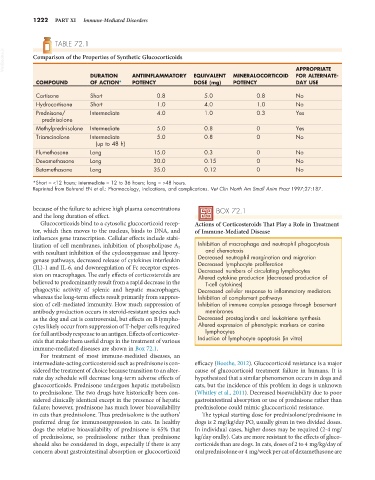Page 1250 - Small Animal Internal Medicine, 6th Edition
P. 1250
1222 PART XI Immune-Mediated Disorders
TABLE 72.1
VetBooks.ir Comparison of the Properties of Synthetic Glucocorticoids
FOR ALTERNATE-
DURATION ANTIINFLAMMATORY EQUIVALENT MINERALOCORTICOID APPROPRIATE
COMPOUND OF ACTION* POTENCY DOSE (mg) POTENCY DAY USE
Cortisone Short 0.8 5.0 0.8 No
Hydrocortisone Short 1.0 4.0 1.0 No
Prednisone/ Intermediate 4.0 1.0 0.3 Yes
prednisolone
Methylprednisolone Intermediate 5.0 0.8 0 Yes
Triamcinolone Intermediate 5.0 0.8 0 No
(up to 48 h)
Flumethasone Long 15.0 0.3 0 No
Dexamethasone Long 30.0 0.15 0 No
Betamethasone Long 35.0 0.12 0 No
*Short = <12 hours; intermediate = 12 to 36 hours; long = >48 hours.
Reprinted from Behrend EN et al.: Pharmacology, indications, and complications. Vet Clin North Am Small Anim Pract 1997;27:187.
because of the failure to achieve high plasma concentrations BOX 72.1
and the long duration of effect.
Glucocorticoids bind to a cytosolic glucocorticoid recep- Actions of Corticosteroids That Play a Role in Treatment
tor, which then moves to the nucleus, binds to DNA, and of Immune-Mediated Disease
influences gene transcription. Cellular effects include stabi-
lization of cell membranes, inhibition of phospholipase A 2 Inhibition of macrophage and neutrophil phagocytosis
with resultant inhibition of the cyclooxygenase and lipoxy- and chemotaxis
genase pathways, decreased release of cytokines interleukin Decreased neutrophil margination and migration
Decreased lymphocyte proliferation
(IL)-1 and IL-6, and downregulation of Fc receptor expres- Decreased numbers of circulating lymphocytes
sion on macrophages. The early effects of corticosteroids are Altered cytokine production (decreased production of
believed to predominantly result from a rapid decrease in the T-cell cytokines)
phagocytic activity of splenic and hepatic macrophages, Decreased cellular response to inflammatory mediators
whereas the long-term effects result primarily from suppres- Inhibition of complement pathways
sion of cell-mediated immunity. How much suppression of Inhibition of immune complex passage through basement
antibody production occurs in steroid-resistant species such membranes
as the dog and cat is controversial, but effects on B lympho- Decreased prostaglandin and leukotriene synthesis
cytes likely occur from suppression of T-helper cells required Altered expression of phenotypic markers on canine
for full antibody response to an antigen. Effects of corticoster- lymphocytes
oids that make them useful drugs in the treatment of various Induction of lymphocyte apoptosis (in vitro)
immune-mediated diseases are shown in Box 72.1.
For treatment of most immune-mediated diseases, an
intermediate-acting corticosteroid such as prednisone is con- efficacy (Boothe, 2012). Glucocorticoid resistance is a major
sidered the treatment of choice because transition to an alter- cause of glucocorticoid treatment failure in humans. It is
nate day schedule will decrease long-term adverse effects of hypothesized that a similar phenomenon occurs in dogs and
glucocorticoids. Prednisone undergoes hepatic metabolism cats, but the incidence of this problem in dogs is unknown
to prednisolone. The two drugs have historically been con- (Whitley et al., 2011). Decreased bioavailability due to poor
sidered clinically identical except in the presence of hepatic gastrointestinal absorption or use of prednisone rather than
failure; however, prednisone has much lower bioavailability prednisolone could mimic glucocorticoid resistance.
in cats than prednisolone. Thus prednisolone is the authors’ The typical starting dose for prednisolone/prednisone in
preferred drug for immunosuppression in cats. In healthy dogs is 2 mg/kg/day PO, usually given in two divided doses.
dogs the relative bioavailability of prednisone is 65% that In individual cases, higher doses may be required (2-4 mg/
of prednisolone, so prednisolone rather than prednisone kg/day orally). Cats are more resistant to the effects of gluco-
should also be considered in dogs, especially if there is any corticoids than are dogs. In cats, doses of 2 to 4 mg/kg/day of
concern about gastrointestinal absorption or glucocorticoid oral prednisolone or 4 mg/week per cat of dexamethasone are

